Junior Product Manager Interview Questions
As a junior product manager, you’re expected to bring a balance of technical understanding, analytical thinking, and strong communication skills. Interviewers will assess both your hard and soft skills through a mix of technical product manager interview questions, behavioral scenarios, and problem-solving tasks. This guide covers the most common junior product manager interview questions to help you prepare for an interview and build confidence.
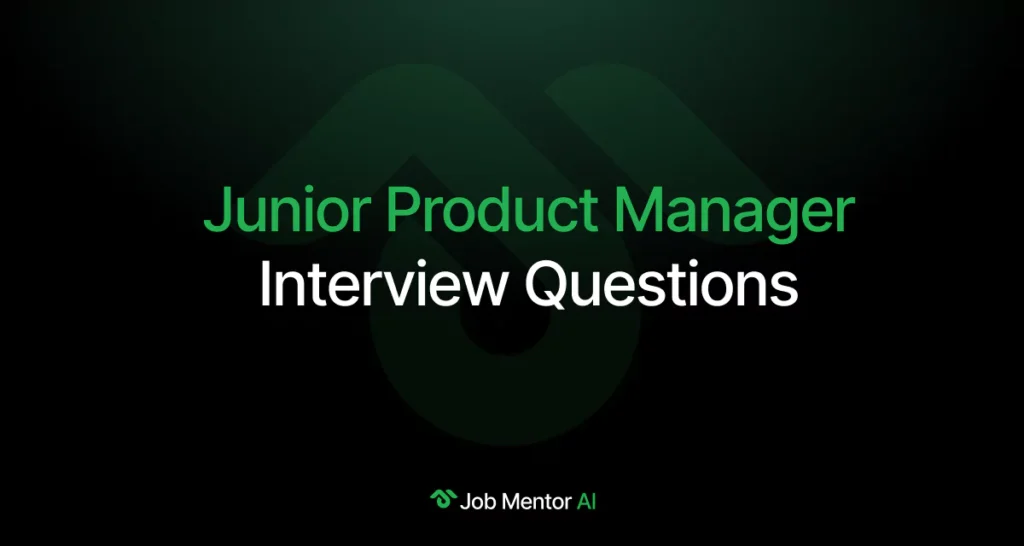
Introductory Phase (About You)
1. Can you tell us about yourself?
2. Why did you choose product management as a career?
3. What interests you most about this role?
4. What are your strengths as a professional?
5. What do you enjoy doing outside of work or studies?
Background and Experience
1. Have you worked on any data-related projects? Can you describe one?
2. Have you ever worked in a cross-functional team?
3. What tools have you used for managing projects?
4. What is your experience with gathering user requirements?
5. What is the most challenging problem you’ve solved in a project?
Technical/Tools Expertise (Role-Specific Skills)
1. What do you know about product roadmaps?
2. What is the difference between a product backlog and a sprint backlog?
3. What tools do you use for data analysis?
4. What is your experience with wireframing or prototyping?
5. How do you prioritize features for a product?
Behavioral and Situational Questions
1. How do you handle tight deadlines for product deliverables?
2. What would you do if a key stakeholder disagreed with your product plan?
3. Describe a time you worked on a team to deliver a project.
4. How do you handle feedback or criticism on your product decisions?
5. What would you do if a feature launch didn’t meet user expectations?
Critical Thinking
1. How would you improve a product you use daily?
2. What steps would you take to prioritize conflicting stakeholder requests?
3. What would you do if your product was not generating enough revenue?
4. How do you decide which user feedback to act on?
5. How would you address a major competitor launching a similar product?
Performance-Based Questions
1. Can you create a basic product roadmap?
2. How would you write a user story for a feature request?
3. How would you analyze user data to improve a feature?
4. Can you outline steps to launch a new product?
5. How would you prepare a report on the performance of a recently launched feature?
Problem-Solving and Analytical Thinking
1. What would you do if your team was behind schedule on a major deliverable?
2. How would you identify the root cause of user churn?
3. How do you balance short-term goals with long-term product vision?
4. What would you do if your product’s KPIs weren’t improving after changes?
5. How do you handle unexpected technical challenges during development?
Career Growth
1. What do you hope to achieve in this role?
2. Where do you see yourself in 3-5 years?
3. What kind of products inspire you?
4. Are you interested in learning more about technical or business aspects?
5. What motivates you to grow as a product manager?
Introductory Phase (About You)
The first part of most interviews revolves around your personal and professional story. This is the interviewee’s chance to make a great first impression. As part of your product manager interview introduction, you need to be able to introduce yourself confidently and align your background with the company’s expectations. Be concise and avoid giving vague answers.
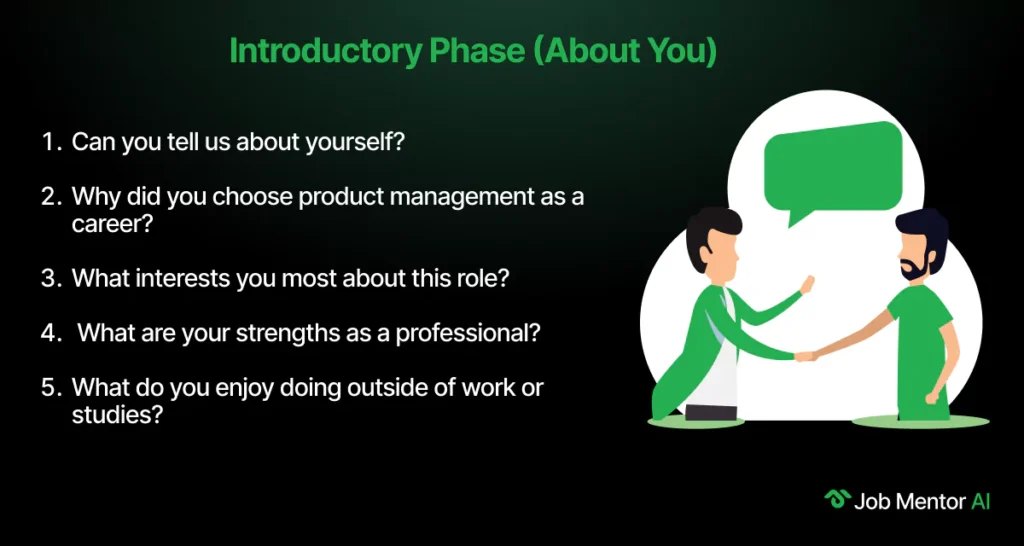
1. Can you tell us about yourself?
What Interviewers Want:
A concise summary of your educational background, interest in product management, and any relevant experience or skills.
Strong Answer:
“I have a degree in Business Administration and a strong interest in technology. During my studies, I interned with a SaaS company, where I collaborated with cross-functional teams to improve a product’s user experience. I enjoy analyzing data, solving problems, and working with diverse teams to build products that create value for users.”
Poor Answer:
“I studied Business Administration and interned at a company where I worked on improving a product.”
2. Why did you choose product management as a career?
What Interviewers Want:
A clear explanation of your passion for solving problems, collaborating with teams, and creating impactful products.
Strong Answer:
“I chose product management because it allows me to combine my analytical and creative skills. I love identifying user needs, collaborating with teams to find solutions, and seeing how a product evolves from an idea to something that positively impacts users. It’s rewarding to be at the intersection of technology, business, and design.”
Poor Answer:
“I enjoy working with teams and solving problems, which is why I chose product management.”
3. What interests you most about this role?
What Interviewers Want:
Enthusiasm for the company’s mission, product, or market.
Strong Answer:
“I’m excited about the opportunity to work on products that solve real-world problems and make a difference for users. I admire your company’s focus on innovation and user-centric design, and I’m eager to contribute by collaborating with your talented team and learning from experienced professionals.”
Poor Answer:
“I’m interested in working on exciting products and learning more about product management.”
4. What are your strengths as a professional?
What Interviewers Want:
Confidence in skills like communication, organization, or analytical thinking.
Strong Answer:
“My strengths include strong communication and organizational skills. I excel at breaking down complex tasks into manageable steps and keeping teams aligned to meet deadlines. I’m also analytical, which helps me make data-driven decisions and identify areas for improvement in a product or process.”
Poor Answer:
“My strengths are being organized, good at communicating, and making decisions.”
5. What do you enjoy doing outside of work or studies?
What Interviewers Want:
Insight into hobbies or activities that reflect curiosity, leadership, or creativity.
Strong Answer:
“In my free time, I enjoy exploring new tools and techniques for productivity and project management, as well as reading books on business strategy and technology trends. I also like hiking and participating in team sports, which help me stay active and build teamwork skills.”
Poor Answer:
“I enjoy reading about business and technology, and I like outdoor activities like hiking.”
Tip: If you want to know how to properly and formally introduce yourself to make a solid first impression, read the full guide on how to introduce yourself in an interview.
Introductory Phase (About You)
1. Can you tell us about yourself?
2. Why did you choose a career in data engineering?
3. What excites you most about this role?
4. What are your strengths as an engineer?
5. What do you enjoy doing outside of work or studies?
Background and Experience
1. Have you worked on any data-related projects? Can you describe one?
2. What tools and technologies have you used for data engineering?
3. Have you ever worked with large datasets? What challenges did you face?
4. What is the most successful project you’ve worked on, and why?
5. How do you stay updated with trends in data engineering?
Technical/Tools Expertise (Role-Specific Skills)
1. What do you know about data pipelines?
2. What is ETL, and how does it differ from ELT?
3. What experience do you have with SQL?
4. Have you worked with any programming languages for data engineering?
5. What is your experience with cloud platforms?
Behavioral and Situational Questions
1. How do you handle tight deadlines for data projects?
2. What would you do if a data pipeline failed in production?
3. Describe a time when you worked with a team to deliver a project.
4. How do you handle feedback or criticism on your work?
5. hat would you do if a data model you built didn’t meet user requirements?
6. Have you ever had to learn a new tool or technology quickly? How did you manage it?
7. What would you do if a client requested real-time data access instead of batch processing?
Critical Thinking
1. How would you design a data pipeline for a retail company?
2. What steps would you take to debug a slow-running query?
3. How do you prioritize tasks when working on multiple projects?
4. What would you do if your data ingestion process was missing records?
5. How would you decide whether to use a relational or non-relational database for a project
Performance-Based Questions
1. Can you write a SQL query to find duplicate records in a table?
2. Can you design a basic data pipeline using an ETL tool or script?
3. How would you optimize a data pipeline to handle increasing data volume?
4. Can you set up a data warehouse schema for reporting?
5. What steps would you take to create a real-time data streaming solution?
Problem-Solving and Analytical Thinking
1. What would you do if a database query took too long to execute?
2. How would you reduce wasted spend in a PPC campaign?
3. What steps would you take to fix a corrupted data file?
4. How do you ensure scalability in your data engineering solutions?
5. What would you do if your data pipeline introduced duplicate records?
Career Growth
1. What do you hope to achieve in this role?
2. Where do you see yourself in 3-5 years?
3. What kind of campaigns inspire you?
4. Are you interested in learning more about other areas of digital marketing?
5. What motivates you to grow as a designer?
Background and Experience
These questions help interviewers understand your product management journey, past projects, and key achievements. Your background and experience in product management highlight how you’ve applied essential skills in real-world scenarios.
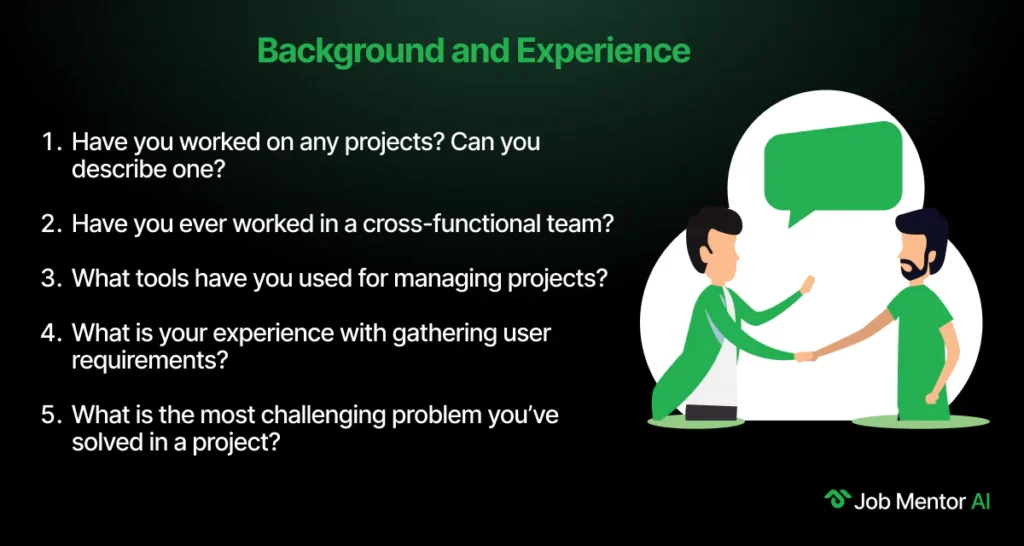
1. Have you worked on any projects? Can you describe one?
What Interviewers Want:
Examples of projects showcasing problem-solving, leadership, or collaboration.
Strong Answer:
“During my internship at a SaaS company, I led a project to streamline the user onboarding process. I collaborated with designers to improve the interface and worked with developers to implement a feature that guided users through key steps. By analyzing user feedback and tracking metrics, we reduced the drop-off rate during onboarding by 15%.”
Poor Answer:
“I worked on improving the onboarding process at my internship by adding new features and working with the team.”
2. Have you ever worked in a cross-functional team?
What Interviewers Want:
Insight into your ability to collaborate with engineers, designers, or marketers.
Strong Answer:
“Yes, in a university project, I worked with a cross-functional team of designers, developers, and marketers to launch a mock e-commerce website. My role was to gather requirements, prioritize features, and ensure alignment between teams. Regular check-ins and clear communication helped us complete the project on time and meet all requirements.”
Poor Answer:
“I worked with different team members on a project and made sure we completed our tasks on time.”
3. What tools have you used for managing projects?
What Interviewers Want:
Familiarity with tools like Jira, Trello, Asana, or similar platforms.
Strong Answer:
“I have experience with tools like Jira and Trello for managing tasks and tracking progress. For example, in one project, I used Trello to create a Kanban board that kept the team aligned on priorities and deadlines. I also used Slack and Google Workspace to facilitate communication and collaboration.”
Poor Answer:
“I’ve used tools like Jira and Trello to manage tasks and communicate with teams.”
4. What is your experience with gathering user requirements?
What Interviewers Want:
Ability to listen, ask the right questions, and translate needs into actionable steps.
Strong Answer:
“I conducted user interviews and created surveys to gather feedback for a project aimed at improving a mobile app. I documented their pain points and prioritized their needs using a MOSCOW framework. This process helped our team focus on high-priority features, which significantly improved user satisfaction.”
Poor Answer:
“I’ve interviewed users and collected feedback to understand their needs and improve features.”
5. What is the most challenging problem you’ve solved in a project?
What Interviewers Want:
Problem-solving skills and an ability to explain your approach.
Strong Answer:
“In a recent project, the team faced a delay due to misaligned priorities among stakeholders. I organized a meeting to clarify goals and priorities, facilitated a discussion to reach a consensus, and updated the project plan to reflect the changes. This resolved the conflict and allowed us to meet our deadline without compromising quality.”
Poor Answer:
“I faced challenges with priorities in a project but worked with the team to align and finish on time.”
Technical/Tools Expertise Product Manager Interview Questions
Recruiters will evaluate your proficiency with different tools, platforms, and data necessary for the role. These technical product manager interview questions also focus on how you work with the technical team to understand their needs, collaborate with them, and contribute to shared goals.
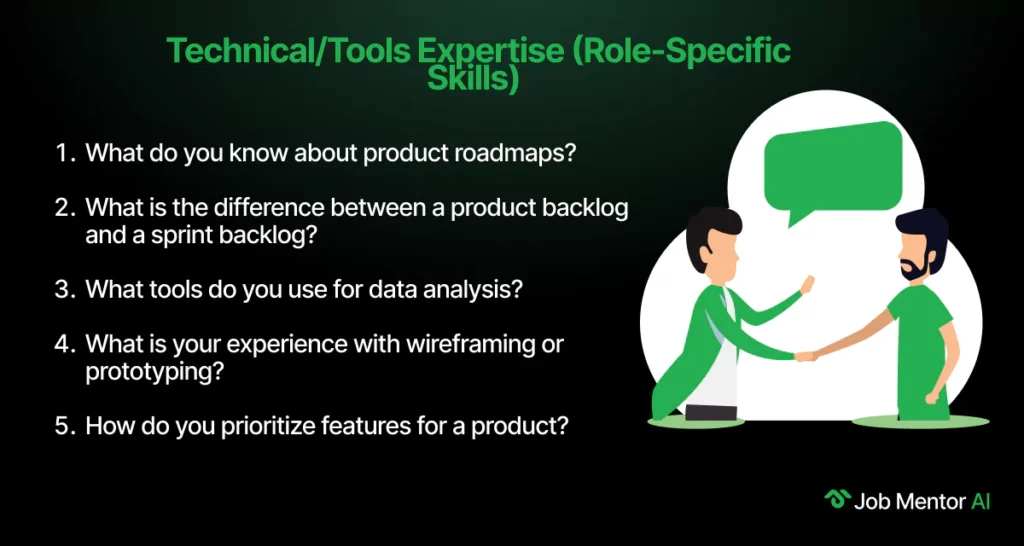
1. What do you know about product roadmaps?
What Interviewers Want:
Understanding of how roadmaps align with business goals and guide development.
Strong Answer:
“A product roadmap is a high-level visual summary that outlines the vision, goals, and strategy for a product over time. It aligns stakeholders by showing what features or improvements are planned, prioritized, and when they’ll be delivered. It helps guide the team’s efforts and ensures the product evolves in line with business objectives and user needs.”
Poor Answer:
“A roadmap shows what features will be developed and when they’ll be delivered.”
2. What is the difference between a product backlog and a sprint backlog?
What Interviewers Want:
Awareness of Agile concepts and their application in managing tasks.
Strong Answer:
“A product backlog is a prioritized list of all features, enhancements, and fixes that the team might work on for a product. A sprint backlog is a subset of the product backlog, containing tasks the team commits to completing during a specific sprint. The product backlog is long-term, while the sprint backlog is short-term and specific.”
Poor Answer:
“The product backlog is all the tasks, and the sprint backlog is what the team focuses on during a sprint.”
3. What tools do you use for data analysis?
What Interviewers Want:
Familiarity with tools like Excel, Google Analytics, or Tableau.
Strong Answer:
“I’ve used tools like Excel for data visualization and pivot tables, Google Analytics for tracking user behavior and engagement, and Tableau for creating dashboards to share insights with stakeholders. These tools help me analyze trends, identify areas for improvement, and make data-driven decisions.”
Poor Answer:
“I use Excel and Google Analytics to analyze data and find insights.”
4. What is your experience with wireframing or prototyping?
What Interviewers Want:
Basic knowledge of tools like Figma, Balsamiq, or Sketch.
Strong Answer:
“I’ve used tools like Figma and Balsamiq to create wireframes and prototypes. For example, I designed a low-fidelity prototype for a new feature, shared it with stakeholders for feedback, and collaborated with designers to refine it into a high-fidelity version. This helped clarify requirements and improve the development process.”
Poor Answer:
“I’ve used tools like Figma to create wireframes for projects and share them with the team.”
5. How do you prioritize features for a product?
What Interviewers Want:
Understanding of prioritization frameworks like MoSCoW, RICE, or user impact.
Strong Answer:
“I use frameworks like MoSCoW or RICE to prioritize features. For example, I evaluate each feature’s impact, urgency, and feasibility. I also consider user feedback and business goals to ensure that high-value features are prioritized. This approach ensures we focus on what matters most.”
Poor Answer:
“I prioritize features based on what’s important and what users want.”
6. What is the purpose of user personas?
What Interviewers Want:
Awareness of how personas guide product decisions and empathy for users.
Strong Answer:
“User personas represent the target audience’s needs, goals, and behaviors. They help the team empathize with users and ensure the product design and features align with their expectations. For example, personas can guide decisions on usability, content, and prioritization.”
Poor Answer:
“Personas show what the users need and help guide the product design.”
7. Can you explain the product development lifecycle?
What Interviewers Want:
Understanding of key phases, from ideation to launch and iteration.
Strong Answer:
“The product development lifecycle includes several stages: ideation, where we identify opportunities and define goals; planning, where we prioritize features and create a roadmap; development, where the product is built; testing, to ensure quality; launch, where the product is released to users; and iteration, where we gather feedback and improve the product over time.”
Poor Answer:
“The lifecycle involves planning, building, testing, and improving the product.”
8. What do you know about A/B testing?
What Interviewers Want:
Awareness of how to test and analyze variations for better user experience.
Strong Answer:
“A/B testing involves creating two variations of a product or feature to test which performs better based on user behavior. For example, testing two versions of a landing page with different headlines to see which one drives more conversions. It’s a data-driven way to optimize user experience and achieve better results.”
Poor Answer:
“A/B testing is testing two versions of something to see which one works better.”
9. How do you measure the success of a product?
What Interviewers Want:
Familiarity with key performance indicators (KPIs) like retention, NPS, or revenue.
Strong Answer:
“I measure success using KPIs like customer retention, Net Promoter Score (NPS), and revenue growth. Depending on the product, I might also track metrics like active users, conversion rates, or user engagement. Regularly monitoring these metrics ensures the product meets its goals and delivers value.”
Poor Answer:
“I look at metrics like user engagement and revenue to measure success.”
10. What is the difference between Agile and Waterfall methodologies?
What Interviewers Want:
Basic understanding of project management approaches.
Strong Answer:
“Agile is an iterative approach that delivers work in small increments, allowing for continuous feedback and adaptation. Waterfall is a sequential approach where each phase, like design and development, is completed before moving to the next. Agile is more flexible, while Waterfall works well for projects with fixed requirements.”
Poor Answer:
“Agile is flexible and done in iterations, while Waterfall follows a step-by-step process.”
11. What is the role of market research in product management?
What Interviewers Want:
Awareness of how research informs product decisions and strategy.
Strong Answer:
“Market research helps identify user needs, industry trends, and competitor strategies. It informs product decisions by ensuring that features align with market demand and user expectations. For example, understanding market gaps can help prioritize features that differentiate the product.”
Poor Answer:
“Market research helps understand user needs and competitor products to guide decisions.”
12. How do you write effective user stories?
What Interviewers Want:
Clarity on writing concise, actionable, and user-focused requirements.
Strong Answer:
“I write user stories in the format: ‘As a [user type], I want to [action], so that [benefit].’ This ensures the story is user-focused and clearly communicates the value. I also include acceptance criteria to define when the story is complete, helping the team deliver the right solution.”
Poor Answer:
“I write user stories based on what users need and include details about the task.”
13. What do you know about stakeholder management?
What Interviewers Want:
Awareness of balancing different perspectives and aligning goals.
Strong Answer:
“Stakeholder management involves aligning diverse perspectives and ensuring everyone is informed and engaged. I communicate regularly, provide updates on progress, and listen to feedback to address concerns. Building strong relationships with stakeholders helps ensure the product aligns with both business and user goals.”
Poor Answer:
“I keep stakeholders informed and work to address their concerns.”
14. How do you handle trade-offs in product development?
What Interviewers Want:
Logical decision-making based on impact, resources, and priorities.
Strong Answer:
“I evaluate trade-offs by considering factors like impact, feasibility, and urgency. For example, if adding a feature delays the timeline, I’d assess its value to users and the business. I’d communicate options with stakeholders to make an informed decision that balances priorities.”
Poor Answer:
“I consider the importance and feasibility of the options and decide based on priorities.”
15. What is your understanding of customer journey mapping?
What Interviewers Want:
Awareness of mapping touchpoints to understand user experience.
Strong Answer:
“Customer journey mapping visualizes the steps a user takes to interact with a product, from discovery to engagement. It helps identify pain points and opportunities for improvement. For example, mapping the onboarding journey might reveal areas where users drop off, enabling us to refine the process.”
Poor Answer:
“Customer journey mapping shows the steps users take and helps identify problems.”
Behavioral and Situational Product Manager Interview Questions
Understanding how you’ve handled past projects and challenges is critical for interviewers. Product manager behavioral interview questions assess teamwork, conflict resolution, leadership, and adaptability. Use the STAR method (Situation, Task, Action, Result) to craft impactful responses. Practice with tools like JobMentor’s AI Mock Interview Practice for project manager interview prep to identify your key strengths and know how to present your answers effectively in an interview.
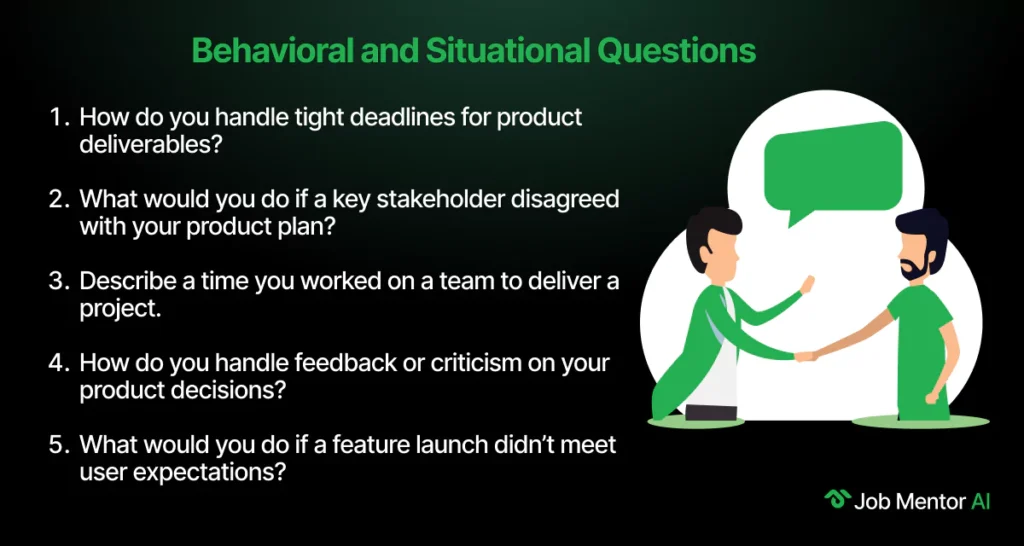
1. How do you handle tight deadlines for product deliverables?
What Interviewers Want:
Time management and prioritization skills.
Strong Answer:
“I prioritize tasks based on their impact and urgency, breaking them into smaller milestones to ensure progress. I communicate with the team to align on expectations and address any bottlenecks. If necessary, I negotiate deadlines or adjust the scope to focus on high-priority deliverables while maintaining quality.”
Poor Answer:
“I focus on completing the most important tasks first and work hard to meet the deadline.”
2. What would you do if a key stakeholder disagreed with your product plan?
What Interviewers Want:
Communication and conflict-resolution skills.
Strong Answer:
“I’d schedule a meeting to understand their concerns and align on priorities. I’d use data, user feedback, or research to explain the reasoning behind the plan while being open to their perspective. If needed, I’d collaborate on a revised plan that addresses their concerns without compromising the product’s goals.”
Poor Answer:
“I’d listen to their concerns and adjust the plan to meet their expectations.”
3. Describe a time you worked on a team to deliver a project.
What Interviewers Want:
Examples of collaboration, communication, and leadership.
Strong Answer:
“In a group project to launch a new feature, I worked closely with developers, designers, and QA specialists. I facilitated regular stand-ups to track progress, resolved blockers by clarifying requirements, and ensured alignment through clear communication. As a result, we delivered the feature on time, and it exceeded user adoption expectations.”
Poor Answer:
“I worked with a team to deliver a feature, and we made sure to meet the deadline and requirements.”
4. How do you handle feedback or criticism on your product decisions?
What Interviewers Want:
Openness to improvement and the ability to iterate based on feedback.
Strong Answer:
“I see feedback as an opportunity to improve. I listen actively to understand the concerns and evaluate the feedback against user data and business goals. For example, when a stakeholder questioned a feature prioritization, I reviewed the data, identified an alternative approach, and incorporated their input into the plan. This led to better alignment and a successful launch.”
Poor Answer:
“I listen to feedback and make changes to improve the product decisions.”
5. What would you do if a feature launch didn’t meet user expectations?
What Interviewers Want:
Problem-solving and ability to learn from failure.
Strong Answer:
“I’d analyze user feedback and metrics, such as adoption rates and engagement, to identify the root cause. Then, I’d work with the team to address the issue, whether it’s improving usability, adding missing functionality, or refining messaging. I’d also communicate transparently with stakeholders about the steps we’re taking to resolve the problem.”
Poor Answer:
“I’d collect user feedback and make changes to improve the feature.”
6. Have you ever worked with a difficult team member? How did you handle it?
What Interviewers Want:
Interpersonal skills and ability to maintain team harmony.
Strong Answer:
“Yes, in one project, a team member missed deadlines due to unclear priorities. I scheduled a one-on-one to understand their challenges and provided clarification on expectations. I also adjusted the workflow to ensure better collaboration. This improved communication and helped us complete the project successfully.”
Poor Answer:
“I talked to the team member and tried to help them meet deadlines.”
7. What would you do if your product was losing users?
What Interviewers Want:
Analytical thinking to identify the cause and take corrective action.
Strong Answer:
“I’d analyze metrics like churn rate, user feedback, and behavior patterns to identify the cause. For example, I’d check if the issue is related to usability, competition, or lack of engagement. Based on the findings, I’d implement targeted improvements, such as enhancing features, fixing pain points, or running a re-engagement campaign.”
Poor Answer:
“I’d look at the data to understand why users are leaving and make changes to address the issue.”
Critical Thinking Product Manager Interview Questions
During interviews, you might be given hypothetical, vague, or tricky situations to see how you handle uncertainty. A strong product management interview prep strategy includes practicing how to break down issues logically and explain your thought process clearly and confidently.
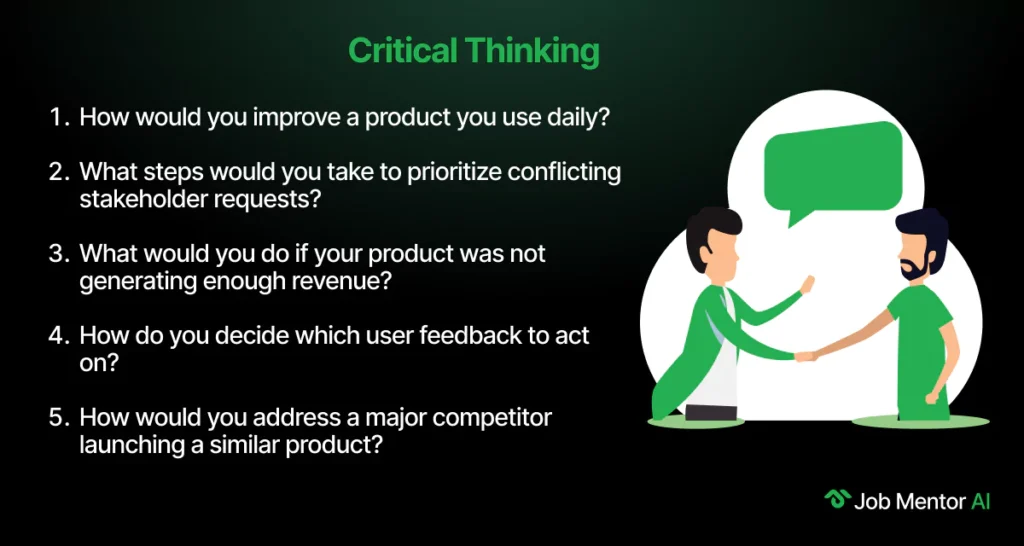
1. How would you improve a product you use daily?
What Interviewers Want:
Creativity, user empathy, and critical thinking.
Strong Answer:
“I’d start by analyzing common pain points or limitations I’ve experienced with the product. For example, if I were improving a task management app, I might add features like recurring tasks or better cross-platform syncing to enhance usability. I’d validate these ideas by gathering feedback from other users to ensure they address widespread needs.”
Poor Answer:
“I’d think about what’s missing and add features to make the product better.”
2. What steps would you take to prioritize conflicting stakeholder requests?
What Interviewers Want:
A structured and logical prioritization process.
Strong Answer:
“I’d evaluate each request based on its alignment with business goals, user impact, and resource feasibility. Using a framework like RICE (Reach, Impact, Confidence, Effort), I’d quantify and compare the potential value of each request. I’d then communicate with stakeholders to explain the prioritization rationale and ensure alignment.”
Poor Answer:
“I’d prioritize the requests based on their importance and explain my decisions to stakeholders.”
3. What would you do if your product was not generating enough revenue?
What Interviewers Want:
Strategic thinking to explore pricing, features, or target markets.
Strong Answer:
“I’d analyze metrics like customer acquisition cost (CAC), churn rate, and user behavior to identify potential issues. I’d explore strategies such as revising pricing models, introducing premium features, or targeting new customer segments. Additionally, I’d gather feedback from current and potential users to understand their needs and willingness to pay.”
Poor Answer:
“I’d look at the data and try new pricing models or add features to increase revenue.”
4. How do you decide which user feedback to act on?
What Interviewers Want:
Awareness of balancing user needs with business goals and feasibility.
Strong Answer:
“I evaluate feedback based on its alignment with the product’s goals, its potential impact on user experience, and feasibility of implementation. I group feedback into themes and prioritize recurring issues or those affecting a large portion of users. For example, if multiple users report difficulty navigating a feature, I’d prioritize improving its usability.”
Poor Answer:
“I’d focus on the feedback that seems most important and feasible to implement.”
5. How would you address a major competitor launching a similar product?
What Interviewers Want:
Strategic thinking to differentiate and improve your product.
Strong Answer:
“I’d conduct a competitive analysis to understand their product’s strengths and weaknesses compared to ours. I’d focus on differentiating our product by emphasizing unique features, improving user experience, or targeting underserved market segments. Additionally, I’d engage with current users to reinforce loyalty and gather insights for future enhancements.”
Poor Answer:
“I’d analyze the competitor’s product and improve ours to make it stand out.”
Performance-Based Product Manager Interview Questions
These questions test your ability to think strategically, manage the entire product management process from start to finish, while driving positive outcomes.
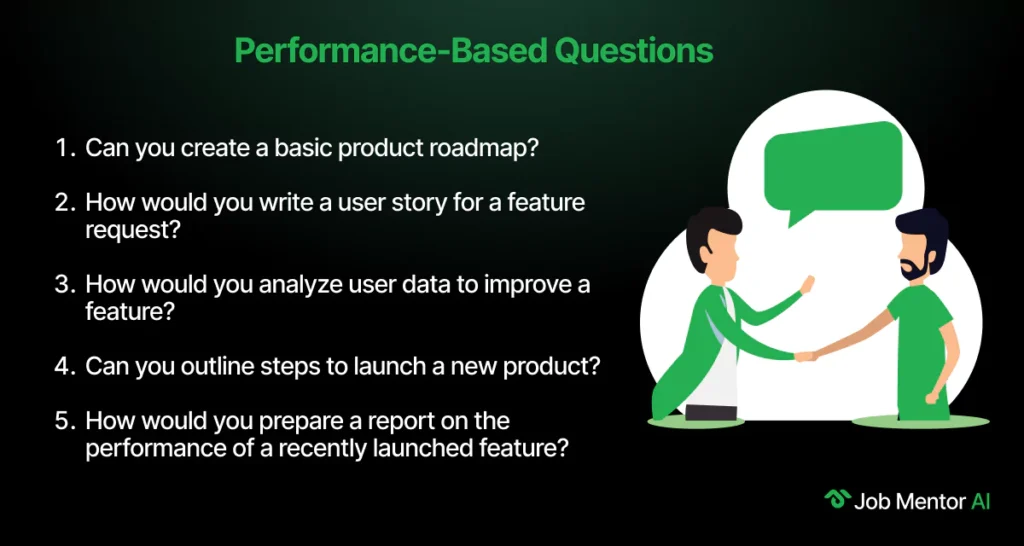
1. Can you create a basic product roadmap?
What Interviewers Want:
Ability to demonstrate an understanding of planning and prioritization.
Strong Answer:
“A basic product roadmap outlines the product’s vision and timeline, broken into phases. For example:
- Phase 1 (Quarter 1): Conduct user research, define key features, and create prototypes.
- Phase 2 (Quarter 2): Develop MVP, perform usability testing, and iterate based on feedback.
- Phase 3 (Quarter 3): Launch the product, collect initial metrics, and plan for feature improvements.
The roadmap is dynamic and should be revisited regularly to ensure alignment with business goals and user needs.”
Poor Answer:
“A product roadmap is a list of features and timelines for when they’ll be delivered.”
2. How would you write a user story for a feature request?
What Interviewers Want:
Practical knowledge of writing clear and actionable user stories.
Strong Answer:
“I use the standard format: ‘As a [type of user], I want to [perform an action], so that [achieve a goal].’ For example:
‘As a user, I want to receive email notifications for new messages so that I can stay updated without checking the app frequently.’
I also include acceptance criteria, such as:
- Notifications must include the sender’s name and a preview of the message.
- Notifications should be delivered within one minute of the message being received.”
Poor Answer:
“I’d write the user story based on what the user wants, like ‘As a user, I want notifications.’”
3. How would you analyze user data to improve a feature?
What Interviewers Want:
Analytical skills and ability to derive insights from data.
Strong Answer:
“I’d start by identifying key metrics, like usage frequency, engagement rates, or drop-off points. For example, if I noticed a high drop-off rate in a multi-step checkout process, I’d analyze user behavior to pinpoint where users abandon the flow. Then, I’d gather qualitative feedback through surveys to understand why. Based on the findings, I’d test improvements like reducing steps or simplifying the interface.”
Poor Answer:
“I’d look at the metrics to see where users are having issues and make changes to improve the feature.”
4. Can you outline steps to launch a new product?
What Interviewers Want:
A clear understanding of the product launch process.
Strong Answer:
- Research: Conduct market research to identify user needs and the competitive landscape.
- Planning: Define goals, features, and success metrics. Create a product roadmap.
- Development: Build the MVP and test for quality assurance.
- Marketing: Develop a go-to-market strategy, including campaigns and user acquisition plans.
- Launch: Release the product, monitor performance, and address any immediate issues.
- Iteration: Collect feedback, analyze metrics, and implement improvements post-launch.
Poor Answer:
“I’d plan the product, launch it, and then analyze how it performs.”
5. How would you prepare a report on the performance of a recently launched feature?
What Interviewers Want:
Understanding of tracking, analyzing, and presenting key metrics.
Strong Answer:
“I’d first define the KPIs, such as user adoption, engagement, and retention rates. Then, I’d collect data from analytics tools to track these metrics. I’d compare the actual performance against the expected outcomes and identify trends or anomalies. The report would include:
- A summary of the feature and its goals.
- Key performance metrics with visualizations like charts.
- Insights on what worked well and areas for improvement.
- Recommendations for the next steps.”
Poor Answer:
“I’d collect data on how the feature performed and share it in a report with some suggestions.”
Problem-Solving and Analytical Thinking Product Manager Interview Questions
These questions are meant to see how you think through problems and approach uncertain situations to come up with logical solutions. You have to explain your thought process thoroughly for them to truly recognize your analytical skills.
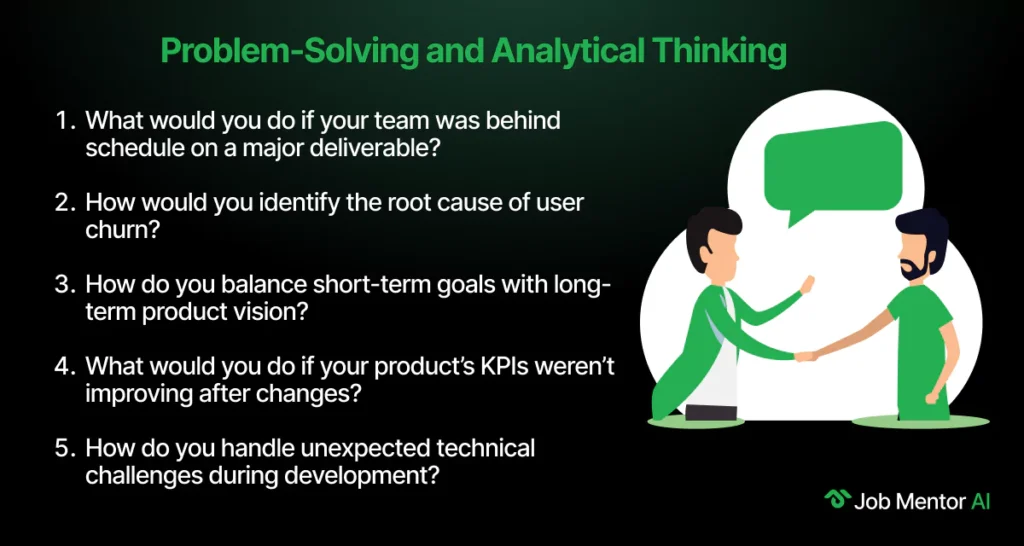
1. What would you do if your team was behind schedule on a major deliverable?
What Interviewers Want:
Problem-solving and ability to re-prioritize tasks effectively.
Strong Answer:
“I’d first identify the reasons for the delay by discussing with the team and reviewing progress. Then, I’d prioritize critical tasks and reallocate resources if possible. If the delay impacts other teams or stakeholders, I’d communicate the situation clearly and propose a revised timeline. I’d also look for opportunities to streamline workflows or adjust the scope while ensuring quality is maintained.”
Poor Answer:
“I’d talk to the team, figure out the problem, and try to adjust the schedule.”
2. How would you identify the root cause of user churn?
What Interviewers Want:
Analytical thinking to investigate and address retention issues.
Strong Answer:
“I’d start by analyzing churn metrics to identify patterns, such as high churn among specific user segments. Then, I’d gather qualitative data through surveys or interviews to understand user pain points. I’d also review the onboarding process, feature engagement, and competitor offerings to pinpoint potential causes. This combination of quantitative and qualitative data helps form actionable solutions.”
Poor Answer:
“I’d look at metrics and ask users for feedback to understand why they’re leaving.”
3. How do you balance short-term goals with long-term product vision?
What Interviewers Want:
Strategic thinking and prioritization skills.
Strong Answer:
“I prioritize short-term goals that align with and contribute to the long-term vision. I use frameworks like OKRs to ensure every short-term deliverable ties back to broader objectives. For example, launching an MVP quickly might be a short-term goal, but it helps validate the long-term vision through user feedback.”
Poor Answer:
“I focus on short-term goals that help achieve the product’s long-term vision.”
4. What would you do if your product’s KPIs weren’t improving after changes?
What Interviewers Want:
Ability to analyze, iterate, and optimize strategies.
Strong Answer:
“I’d revisit the data to understand why the changes didn’t deliver the expected results. I’d check if the implementation aligns with user needs or if there were unintended consequences. Based on the findings, I’d adjust the strategy, test new approaches, and continue monitoring metrics closely. For example, if engagement dropped, I’d review user feedback to identify missed expectations.”
Poor Answer:
“I’d analyze the metrics again and try to make new changes to improve the KPIs.”
5. How do you handle unexpected technical challenges during development?
What Interviewers Want:
Problem-solving and collaboration with the technical team.
Strong Answer:
“I’d collaborate with the technical team to fully understand the challenge and explore potential solutions. If the challenge impacts the timeline or scope, I’d communicate the issue to stakeholders and adjust expectations. For example, if a feature requires more time than anticipated, I’d evaluate whether it can be simplified or deferred without compromising the overall goal.”
Poor Answer:
“I’d work with the technical team to resolve the challenge and adjust the timeline if needed.”
6. What steps would you take to improve user engagement on a platform?
What Interviewers Want:
Creativity and data-driven decision-making.
Strong Answer:
“I’d start by analyzing user behavior data to identify where engagement drops off. Then, I’d gather user feedback through surveys or usability testing to understand their needs. Based on insights, I’d implement targeted improvements, like adding gamification, streamlining navigation, or enhancing content. I’d test the changes through A/B testing to measure their impact on engagement.”
Poor Answer:
“I’d analyze user data and make improvements like simplifying navigation or adding features to increase engagement.”
7. What would you do if your team was over budget for a project?
What Interviewers Want:
Logical decision-making to reallocate resources or cut non-essential features.
Strong Answer:
“I’d review the project scope and spending to identify areas where costs can be reduced without compromising key deliverables. I’d work with stakeholders to reassess priorities and defer non-essential features or phases if necessary. Clear communication about trade-offs ensures alignment and avoids compromising the project’s success.”
Poor Answer:
“I’d look for ways to reduce costs and talk to stakeholders about adjusting the scope.”
8. How would you address poor feedback from a user survey?
What Interviewers Want:
A focus on improving user satisfaction through actionable changes.
Strong Answer:
“I’d categorize the feedback into themes to identify the most common issues. Then, I’d prioritize addressing high-impact areas, such as usability concerns or missing features. For example, if users report difficulty navigating the platform, I’d conduct usability testing and implement improvements. I’d also communicate updates to users to show that their feedback is valued.”
Poor Answer:
“I’d review the feedback, address the most common issues, and make changes to improve the product.”
9. How do you approach setting realistic deadlines for a new feature?
What Interviewers Want:
Awareness of scope, resources, and team capacity.
Strong Answer:
“I collaborate with the development team to estimate the effort required based on the feature’s complexity and dependencies. I account for potential risks and buffer time for testing and feedback. By breaking the feature into smaller tasks, we can create a timeline that is both realistic and flexible.”
Poor Answer:
“I’d discuss with the team to estimate the time needed and set a deadline accordingly.”
10. How would you decide which feature to build next?
What Interviewers Want:
Strategic prioritization based on impact, feasibility, and alignment with goals.
Strong Answer:
“I’d evaluate features based on user feedback, business goals, and technical feasibility. Using a prioritization framework like RICE (Reach, Impact, Confidence, Effort), I’d quantify the value of each feature. For example, if one feature addresses a critical user need and has high potential for engagement, I’d prioritize it over less impactful options.”
Poor Answer:
“I’d prioritize the feature that’s most important for users and aligns with business goals.”
Career Growth Product Manager Interview Questions
Companies want to know if you’re in it for the long run. You should be prepared to discuss long-term vision and how the role in the company aligns with your growth.
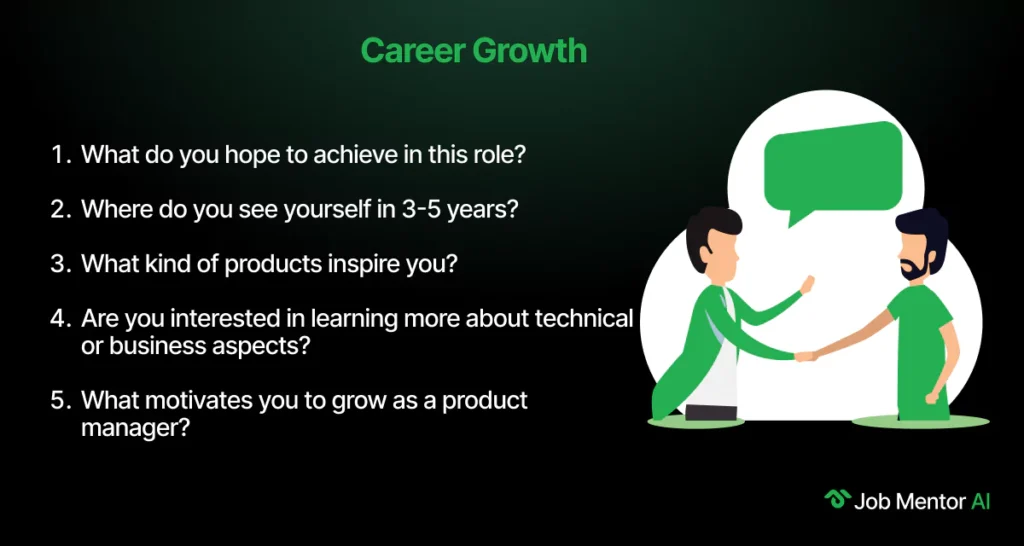
1. What do you hope to achieve in this role?
What Interviewers Want:
A clear desire to learn and grow in product management.
Strong Answer:
“I hope to deepen my understanding of the product development lifecycle and refine my skills in areas like user research, prioritization, and stakeholder management. I’m excited to contribute to impactful projects while learning from experienced team members and aligning my work with the company’s mission.”
Poor Answer:
“I want to improve my product management skills and work on interesting projects.”
2. Where do you see yourself in 3-5 years?
What Interviewers Want:
A vision of long-term growth in product management or leadership.
Strong Answer:
“In 3-5 years, I see myself as a senior product manager leading cross-functional teams to deliver innovative solutions. I also want to mentor junior team members and contribute to shaping the product vision at a strategic level. My goal is to be a trusted leader who drives measurable results for both users and the business.”
Poor Answer:
“I want to grow into a senior role and take on more responsibilities.”
3. What kind of products inspire you?
What Interviewers Want:
Passion for impactful or innovative products.
Strong Answer:
“I’m inspired by products that simplify complex tasks and create meaningful impact, like collaboration tools or healthcare apps. For example, I admire how some apps use intuitive design and advanced technology to solve real-world problems while making the user experience seamless.”
Poor Answer:
“I like products that are innovative and solve real problems for users.”
4. Are you interested in learning more about technical or business aspects?
What Interviewers Want:
Interest in expanding complementary skills.
Strong Answer:
“I’m eager to expand my knowledge in both areas. I want to improve my technical understanding to better collaborate with engineering teams and make informed decisions about feasibility. I’m also interested in deepening my business acumen, such as understanding market dynamics and revenue strategies, to align product development with business goals.”
Poor Answer:
“I’m interested in learning more about both technical and business aspects to improve my skills.”
5. What motivates you to grow as a product manager?
What Interviewers Want:
A passion for solving problems and delivering value to users.
Strong Answer:
“I’m motivated by the opportunity to solve challenging problems and deliver products that make a difference in people’s lives. I enjoy collaborating with diverse teams and learning from their expertise. Seeing the positive impact of my work, whether it’s improving user satisfaction or driving business growth, keeps me excited about growing in this field.”
Poor Answer:
“I like solving problems and seeing the results of my work, which motivates me to grow.”
Want to Stand Out in Your Next Interview?
Boost your interview preparation with Job Mentor AI, designed to provide personalized feedback and simulated interview experiences.
To refine your skills further, use our AI Interview Answer Generator. This tool helps you practice answering a range of interview questions, improving your response accuracy and confidence. With these resources, you’ll feel more prepared, whether you’re facing behavioral questions or technical challenges. Boost your interview preparation with Job Mentor AI, designed to provide personalized feedback and simulated interview experiences.
Questions to ask interviewer
- What tools and platforms will I use in this role?
- What are the team’s goals for the product in the next year?
- What kind of training or mentorship opportunities are available?
- How does the product team collaborate with other departments?
- What are the next steps in the hiring process?
Junior Product Manager Interview Questions
Table of Contents
Recommended Resources

Top 40 SOC Analyst Interview Questions
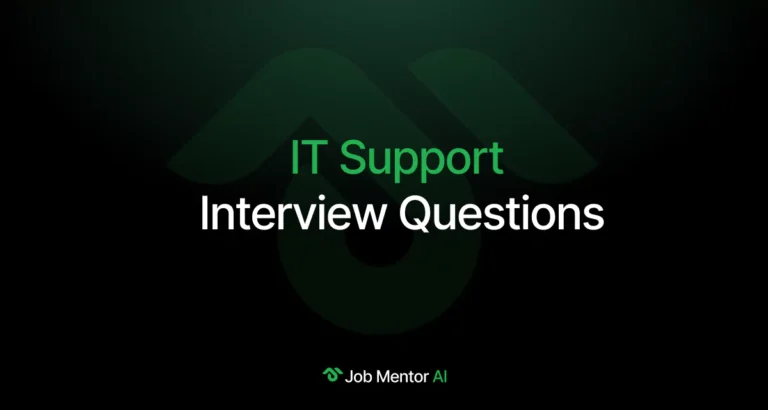
IT Support Interview Questions

Top 50 AI Engineer Interview Questions

50 Must Know Cyber Security Interview Questions Answers
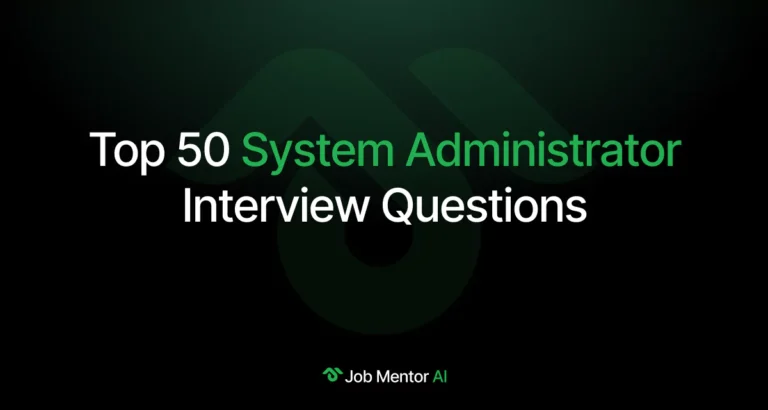
Top 50 System Administrator Interview Questions

Top 60 Azure Data Engineer Interview Questions
